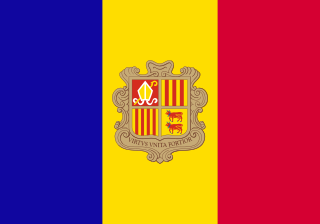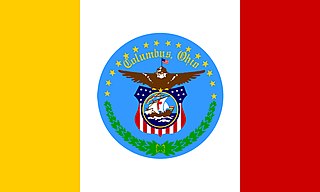
The national flag of France is a tricolour flag featuring three vertical bands coloured blue, white, and red. It is known to English speakers as the Tricolour,, although the flag of Ireland and others are also so known. The design was adopted after the French Revolution; while not the first tricolour, it became one of the most influential flags in history. The tricolour scheme was later adopted by many other nations in Europe and elsewhere, and, according to the Encyclopædia Britannica has historically stood "in symbolic opposition to the autocratic and clericalist royal standards of the past".

The flag of Chile consists of two equal-height horizontal bands of white and red, with a blue square the same height as the white band in the canton, which bears a white five-pointed star in the center. It was adopted on 18 October 1817. The Chilean flag is also known in Spanish as La Estrella Solitaria.

The national flag of Romania is a tricolor. The Constitution of Romania states that "The flag of Romania is tricolor; the colors are arranged vertically in the following order from the flagpole: blue, yellow, red". The flag has a width-length ratio of 2:3; the proportions, shades of color as well as the flag protocol were established by law in 1994, and extended in 2001.

The last Soviet Union (USSR)-era flag was adopted by the Russian SFSR in 1954 and used until 1991. The flag of the Russian SFSR was a defacement of the flag of the Soviet Union. The constitution stipulated:
The state flag of the Russian Soviet Federative Socialist Republic (SFSR) presents itself as a red, rectangular sheet with a light-blue stripe at the pole extending all the width [read height] which constitutes one eighth length of the flag.

The national flag of Ivory Coast is a vertical tricolor consisting of equal bands of orange, white, and green. The proportions of the flag are 2:3. It is also the national emblem of the Republic of Ivory Coast as affirmed in Article 29 of the Constitution of Ivory Coast in 1960.

The flag of Montenegro has a red field with gold border and the coat of arms of Montenegro in its center. It was officially adopted on 13 July 2004, when the then Republic of Montenegro was a constituent of the State Union of Serbia and Montenegro, and its precise specification was standardized on 16 September 2004. The flag was retained after Montenegrin independence in 2006, and mandated by Article 4 of the Constitution of Montenegro adopted in 2007.

The national flag of the Principality of Andorra features a vertical tricolor of blue, yellow, and red with the coat of arms of Andorra in the center. Although the three vertical bars may at first appear to be of equal width, the centre yellow bar is slightly wider than the other two so that the ratio of bar widths is 8:9:8 with an overall flag ratio of 7:10.

The national flag of Ecuador, which consists of horizontal bands of yellow, blue and red, was first adopted by law in 1835 and later on 26 September 1860. The design of the current flag was finalized in 1900 with the addition of the coat of arms in the center of the flag. Before using the yellow, blue and red tricolor, Ecuador used white and blue flags that contained stars for each province of the country. The design of the flag is very similar to those of Colombia and Venezuela, which are also former constituent territories of Gran Colombia. All three are based on a proposal by Venezuelan General Francisco de Miranda, which was adopted by Venezuela in 1811 and later Gran Colombia with some modifications. There is a variant of the flag that does not contain the coat of arms that is used by the merchant marine. This flag matches Colombia's in every aspect, but Colombia uses a different design when her merchant marine ships are at sail. Along with Haiti, the Dominican Republic and El Salvador, it is one of only four national flags whose design incorporates a depiction of the flag itself.

The national flag of Tajikistan was adopted in November 1992, replacing the flag of the Tajik Soviet Socialist Republic of 1953. The flag is a horizontal tricolor of red, white and green, with a yellow crown surmounted by an arc of seven stars at the centre. It has a width ratio of 2:3:2. The tricolor preserves the choice of colors in the former Tajik Soviet flag, as well as the 1:2 proportions.

Komi-Permyak Okrug, or Permyakia is a territory with special status within Perm Krai, Russia. Its administrative center is the town of Kudymkar. Population: 116,157 (2010 Census); 136,076 (2002 Census); 159,689 (1989 Census).

The flag of the Republic of Sakha (Yakutia), in the Russian Federation, is one of the official symbols of the Sakha Republic, alongside the coat of arms and the national anthem of the Sakha Republic. The flag has four horizontal stripes. From top to bottom, the stripes are light blue, white (1/16), red (1/16), and green (1/8). The flag has been used officially as the flag of the Sakha Republic since 14 October 1992. The light blue stripe is charged with a white disc in the center. The diameter of the disc is 2/5 of the flag's width.

The flag of Crimea is the flag of the Autonomous Republic of Crimea claimed by Ukraine and the Republic of Crimea claimed by Russia. The flag was officially adopted on 24 September 1992 as the flag of the Autonomous Republic of Crimea, readopted on 21 April 1999, then readopted on 4 June 2014 as the flag of the Republic of Crimea, annexed by Russian Federation.

The Flag of the Komi Republic in Russia is one of the official symbols of the federal subject, alongside the coat of arms and the State Anthem of the Komi Republic. The flag is a horizontal tricolour with 2:3 proportion. The flag was composed of three bars of, from top to bottom, medium blue, green, and white.

The Jewish Autonomous Oblast is situated in the Far Eastern Federal District of Russia.

The flag of Evenk Autonomous Okrug, in the Russian Federation, is a horizontal tricolor of light blue, white, and dark blue, all of which stand for the polar days and nights in Northern Siberia. It is charged in the center by a red kumalan, the solar emblem in Evenki culture.

The flag of Perm Krai of Russia is a rectangular panel divided by a white cross, which is the St. George's Cross of the patron of Russia, charged with the coat of arms of the krai in the centre. The corners of the panel are divided into two colours: red at the top-left and bottom-right, and blue at the top-right and bottom-left. The flag was, until 2004, the flag of the Perm Oblast, which was merged with Komi-Permyak Autonomous Okrug to form Perm Krai.

The state flag of Berlin has three stripes of red-white-red, the two outer stripes each occupying a fifth of its height, the middle the remaining three fifths. It is emblazoned with a bear on the civil flag, while it bears the coat of arms of Berlin on the state flag.

The flag of the Republic of Bashkortostan, in the Russian Federation, is one of the official symbols of the Republic of Bashkortostan, alongside the coat of arms and the national anthem of Bashkortostan. The flag has three horizontal stripes. From top to bottom, the stripes are green, white, and teal blue. The flag has been used officially as the flag of the Republic of Bashkortostan since 25 February 1992. The white stripe of the flag is charged with a Kurai flower in the center.

The flag of Mecklenburg–Vorpommern is the flag used by the German state of Mecklenburg-Vorpommern.

The flag of Columbus is the official municipal flag of Columbus, Ohio. Its current design is a yellow, white, red vertical triband with the city seal on a blue field. Officially, the flag was adopted in 1929, although it is unknown if the flag was ever flown when it was first adopted.





















